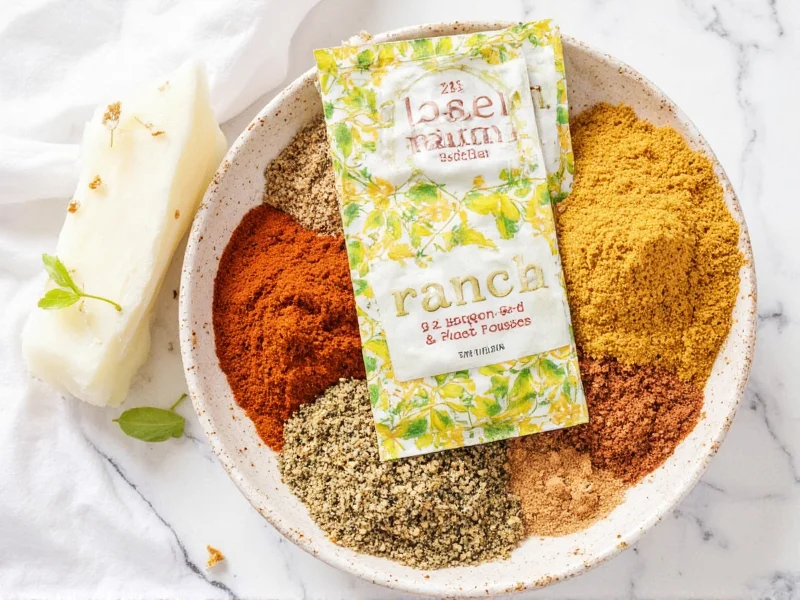What's Inside Ranch Seasoning Packets
Ranch seasoning packets deliver consistent flavor with minimal effort. Understanding their composition helps you use them effectively in various recipes. Most commercial ranch seasoning packets contain these core ingredients:
| Common Ingredients | Typical Percentage | Flavor Contribution |
|---|---|---|
| Garlic powder | 15-20% | Pungent, savory base note |
| Onion powder | 15-20% | Sweet, aromatic foundation |
| Buttermilk powder | 25-30% | Creamy tanginess |
| Dried dill | 5-10% | Herbal freshness |
| Dried parsley | 5-10% | Grassy undertones |
| Salt | 15-20% | Flavor enhancer |
While most ranch seasoning packet ingredients list follows this general pattern, variations exist between brands. Some premium options include natural flavors, citric acid for tang, or xanthan gum as a thickener. Organic ranch seasoning packets often replace buttermilk powder with nutritional yeast for a dairy-free alternative. When examining ranch seasoning packet nutrition facts, note that a single serving (about 1 teaspoon dry mix) typically contains 5-15 calories, 100-250mg sodium, and minimal fat.
How to Use Ranch Seasoning Packets Beyond Dressing
Many home cooks only use ranch seasoning packets for making dressing, but their versatility extends far beyond this basic application. Understanding how to use ranch seasoning packet for chicken transforms ordinary poultry into flavorful meals. Simply mix one packet with 1/4 cup olive oil and 2 tablespoons lemon juice for an excellent marinade.
For roasted vegetables, combine a ranch seasoning packet with 3 tablespoons melted butter or olive oil, then toss with your favorite vegetables before roasting. This technique works particularly well with potatoes, broccoli, and cauliflower. When preparing ranch seasoning packet dip, mix one packet with 1 cup mayonnaise and 1/2 cup buttermilk for a thicker, restaurant-style dip.
Creative cooks also use ranch seasoning in unexpected ways. Add one packet to 2 cups of mashed potatoes for instant flavor. Mix into meatloaf or burger patties for added moisture and taste. Sprinkle directly onto popcorn for a savory snack. When making ranch seasoning packet biscuits, incorporate one packet into your dry ingredients for herbaceous, flavorful bread.
Ranch Seasoning Packet Substitutions and Homemade Alternatives
If you've run out of your favorite ranch seasoning packet, several substitution options maintain similar flavor profiles. The most accurate ranch seasoning packet substitute combines 2 tablespoons dried parsley, 1 tablespoon garlic powder, 1 tablespoon onion powder, 1 tablespoon dried dill, 1 teaspoon paprika, 1/2 teaspoon black pepper, and 1/4 cup buttermilk powder.
For those seeking a dairy-free ranch seasoning packet alternative, replace buttermilk powder with 2 tablespoons nutritional yeast plus 1 tablespoon lemon juice powder. This creates a similar tang without dairy ingredients. When making ranch seasoning without buttermilk, increase the lemon juice powder to 2 tablespoons and add 1 tablespoon maltodextrin for texture.
Understanding ranch seasoning packet to dry ranch conversion helps when scaling recipes. One standard 1-ounce packet equals approximately 3 tablespoons of dry seasoning mix. This knowledge proves valuable when adapting recipes that call for specific amounts of seasoning.
Perfect Pairings: Dishes That Shine with Ranch Seasoning
Ranch seasoning enhances numerous dishes beyond the obvious salad dressing application. For chicken recipes using ranch seasoning packet, try these approaches:
- Ranch-baked chicken: Mix one packet with 1/2 cup mayonnaise and spread over chicken breasts before baking
- Ranch grilled chicken: Combine one packet with 1/4 cup olive oil and 2 tablespoons vinegar for marinade
- Ranch chicken salad: Mix one packet with 1 cup Greek yogurt for dressing base
Vegetable preparations benefit significantly from ranch seasoning. Toss green beans with melted butter and one packet before roasting. Mix into coleslaw dressing for added complexity. Sprinkle directly onto corn on the cob for a flavorful twist.
When exploring ranch seasoning packet recipes for snacks, consider these ideas: coat roasted chickpeas in oil and seasoning for crunchy bites, mix into popcorn for movie night, or blend with melted cheese for a ranch cheese dip.
Storage and Shelf Life Considerations
Proper storage extends the shelf life of ranch seasoning packets significantly. Unopened packets typically remain fresh for 18-24 months when stored in a cool, dry place. Once opened, transfer unused seasoning to an airtight container to prevent moisture absorption, which causes clumping and flavor degradation.
Signs your ranch seasoning packet has spoiled include:
- Clumping that doesn't break apart when shaken
- Musty or sour odor instead of fresh herbal scent
- Visible moisture or discoloration
- Significantly diminished flavor when tested
For long-term storage, consider freezing ranch seasoning packets in their original packaging inside a sealed freezer bag. This method preserves freshness for up to 3 years. When making homemade ranch seasoning mix in bulk, store it in glass jars away from light and heat sources.
Nutritional Profile and Dietary Considerations
While ranch seasoning packets add flavor with minimal calories, they often contain significant sodium. A typical packet contains 400-600mg sodium, which represents 17-26% of the recommended daily limit. Low sodium ranch seasoning packet options reduce this to 150-250mg per serving.
For those following specific dietary patterns:
- Gluten-free diets: Most ranch seasoning packets are naturally gluten-free, but check for hidden gluten sources
- Dairy-free diets: Look for versions using nutritional yeast instead of buttermilk powder
- Keto diets: Ranch seasoning generally fits keto macros, but verify carb counts
- Vegan diets: Buttermilk powder contains dairy, so seek plant-based alternatives
When comparing ranch seasoning packet brands, examine ingredient quality. Higher quality options avoid artificial flavors, MSG, and excessive preservatives. Organic ranch seasoning packets typically use non-GMO ingredients and avoid synthetic additives.











 浙公网安备
33010002000092号
浙公网安备
33010002000092号 浙B2-20120091-4
浙B2-20120091-4